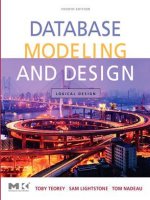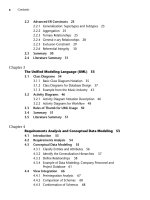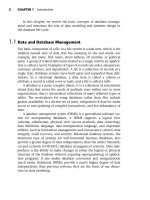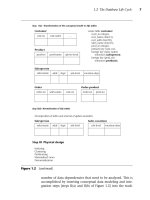Database Modeling & Design Fourth Edition- P11 ppsx
Bạn đang xem bản rút gọn của tài liệu. Xem và tải ngay bản đầy đủ của tài liệu tại đây (163.89 KB, 5 trang )
3.1 Class Diagrams 37
among multiple objects. For example, a Car may belong to more than
one Car Pool. The aggregation association is indicated with a hollow dia-
mond attached to the class that holds the parts. Figure 3.1 indicates that
a Car Pool aggregates Cars.
Composition is another “part of” association in which the parts are
strictly owned, not shared. For example, a Frame is part of a single Car.
The notation for composition is an association adorned with a solid
black diamond attached to the class that owns the parts. Figure 3.1 indi-
cates that a Frame is part of the composition of a Car.
Generalization is another common relationship. For example, Sedan
is a type of car. The “Car” class is more general than the “Sedan” class.
Generalization is indicated by a solid line adorned with a hollow arrow-
head pointing to the more general class. Figure 3.1 shows generalization
from the Sedan class to the Car class.
3.1.2 Class Diagrams for Database Design
The reader may be interested in the similarities and differences between
UML class diagrams and ER models. Figures 3.2 through 3.5 parallel
some of the figures in Chapter 2, allowing for easy comparison. We then
turn our attention to capturing primary key information in Figure 3.6.
We conclude this section with an example database schema of the music
industry, illustrated by Figures 3.7 through 3.10.
Figure 3.2 illustrates UML constructs for relationships with various
degrees of association and multiplicities. These examples are parallel to
the ER models shown in Figure 2.2. You may refer back to Figure 2.2 if
you wish to contrast UML constructs with ER constructs.
Associations between classes may be reflexive, binary or n-ary. Reflex-
ive association is a term we are carrying over from ER modeling. It is not a
term defined in UML, although it is worth discussing. Reflexive associa-
tion relates a class to itself. The reflexive association in Figure 3.2 means
an Employee in the role of manager is associated with many managed
Employees. The roles of classes in a relationship may be indicated at the
ends of the relationship. The number of objects involved in the relation-
ship, referred to as multiplicity, may also be specified at the ends of the
relationship. An asterisk indicates that many objects take part in the
association at that end of the relationship. The multiplicities of the
reflexive association example in Figure 3.2 indicate that an Employee is
associated with one manager, and a manager is associated with many
managed Employees.
Teorey.book Page 37 Saturday, July 16, 2005 12:57 PM
38 CHAPTER 3 The Unified Modeling Language (UML)
A binary association is a relationship between two classes. For exam-
ple, one Division has many Departments. Notice the solid black diamond
at the Division end of the relationship. The solid diamond is an adorn-
Figure 3.2 Selected UML relationship types (parallel to Figure 2.2)
Department
Department
Department
Office
Employee
Employee
Employee
Employee
Employee
Project
1
1
Employee
Department
Division
Project
1
managed
manager 1
*
Skill
skill used
Employee
assignment
manager
manager
0 1
occupant
0 *
WorkAssignment
task-assignment
start-date
reflexive
association
binary
association
ternary
association
Degree
Multiplicities
one-to-one
one-to-many
many-to-many
optional
mandatory
Existence
1
1
1
*
*
*
*
**
*
Representation & ExampleConcept
Teorey.book Page 38 Saturday, July 16, 2005 12:57 PM
3.1 Class Diagrams 39
ment to the associations that indicates composition. The Division is com-
posed of Departments.
The ternary relationship in Figure 3.2 is an example of an n-ary asso-
ciation—an association that relates three or more classes. All classes par-
taking in the association are connected to a hollow diamond. Roles and/
or multiplicities are optionally indicated at the ends of the n-ary associa-
tion. Each end of the ternary association example in Figure 3.2 is marked
with an asterisk, signifying many. The meaning of each multiplicity is
isolated from the other multiplicities. Given a class, if you have exactly
one object from every other class in the association, the multiplicity is
the number of associated objects for the given class. One Employee
working on one Project assignment uses many Skills. One Employee uses
one Skill on many Project assignments. One Skill used on one Project is
fulfilled by many Employees.
The next three class diagrams in Figure 3.2 show various combina-
tions of multiplicities. The illustrated one-to-one association specifies
that each Department is associated with exactly one Employee acting in
the role of manager, and each manager is associated with exactly one
Department. The diagram with the one-to-many association means that
each Department has many Employees, and each Employee belongs to
exactly one Department.
The many-to-many example in Figure 3.2 means each Employee
associates with many Projects, and each Project associates with many
Employees. This example also illustrates the use of an association class.
If an association has attributes, these are written in a class that is
attached to the association with a dashed line. The association class
named “WorkAssignment” in Figure 3.2 contains two association
attributes named “task-assignment” and “start-date.” The association
and the class together form an association class.
Multiplicity can be a range of integers, written with the minimum
and maximum values separated by two periods. The asterisk by itself car-
ries the same meaning as the range [0 *]. Also, if the minimum and
maximum are the same number, then the multiplicity can be written as
a single number. For example, [1 1] means the same as [1]. Optional
existence can be specified using a zero. The [0 1] in the optional exist-
ence example of Figure 3.2 means an Employee in the role of manager is
associated with either no Department (e.g., is upper management), or
one Department.
Mandatory existence is specified whenever a multiplicity begins with
a positive integer. The example of mandatory existence in Figure 3.2
means an Employee is an occupant of exactly one Office. One end of an
Teorey.book Page 39 Saturday, July 16, 2005 12:57 PM
40 CHAPTER 3 The Unified Modeling Language (UML)
association can indicate mandatory existence, while the other end may
use optional existence. This is the case in the example, where an Office
may have any number of occupants, including zero.
Generalization is another type of relationship; a superclass is a gener-
alization of a subclass. Specialization is the opposite of generalization; a
subclass is a specialization of the superclass. The generalization relation-
ship in UML is written with a hollow arrow pointing from the subclass
to the generalized superclass. The top example in Figure 3.3 shows four
subclasses: Manager, Engineer, Technician, and Secretary. These four
subclasses are all specializations of the more general superclass
Employee; that is, Managers, Engineers, Technicians, and Secretaries are
types of Employees.
Notice the four relationships share a common arrowhead. Semanti-
cally, these are still four separate relationships. The sharing of the arrow-
head is permissible in UML, to improve the clarity of the diagrams.
The bottom example in Figure 3.3 illustrates that a class can act as
both a subclass in one relationship, and a superclass in another relation-
Figure 3.3 UML generalization constructs (parallel to Figure 2.4)
Employee
Secreta
ry
Technician
EngineerManager
Individual
Customer
Employee
EmpCust
Complete
enumeration of
subclasses
Teorey.book Page 40 Saturday, July 16, 2005 12:57 PM
3.1 Class Diagrams 41
ship. The class named Individual is a generalization of the Employee and
Customer classes. The Employee and Customer classes are in turn super-
classes of the EmpCust class. A class can be a subclass in more than one
generalization relationship. The meaning in the example is that an Emp-
Cust object is both an Employee and a Customer.
You may occasionally find that UML doesn’t supply a standard sym-
bol for what you are attempting to communicate. UML incorporates
some extensibility to accommodate user needs, such as a note. A note in
UML is written as a rectangle with a dog-eared upper right corner. The
note can attach to the pertinent element(s) with a dashed line(s). Write
briefly in the note what you wish to convey. The bottom diagram in Fig-
ure 3.3 illustrates a note, which describes the Employee and Customer
classes as the “Complete enumeration of subclasses.”
The distinction between composition and aggregation is sometimes
elusive for those new to UML. Figure 3.4 shows an example of each, to
help clarify. The top diagram means that a Program and Electronic Doc-
umentation both contribute to the composition of a Software Product.
The composition signifies that the parts do not exist without the Soft-
ware Product (there is no software pirating in our ideal world). The bot-
tom diagram specifies that a Teacher and a Textbook are aggregated by a
course. The aggregation signifies that the Teacher and the Textbook are
part of the Course, but they also exist separately. If a Course is canceled,
the Teacher and the Textbook continue to exist.
Figure 3.4 UML aggregation constructs (parallel to Figure 2.5)
Program Electronic Documentation
Software Product
Teacher Textbook
Course
Teorey.book Page 41 Saturday, July 16, 2005 12:57 PM









